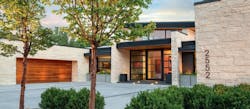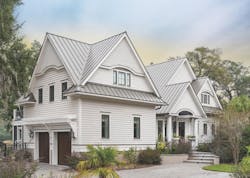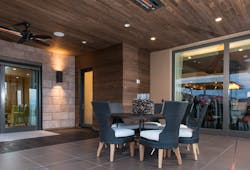4 Exterior Product Trends to Know Now
Deciding on the right siding for a home can be complicated. Budget, durability, and maintenance must be considered, as well as regional preferences, design trends, available labor, local planning guidelines, climatic conditions, and the home’s architecture. So when building and architecture professionals are asked what the most popular materials are, answers vary, depending on what are the key drivers of a particular project. (All photos courtesy manufacturers.)
“As you move up the market, architectural style becomes more diverse, so there is a wider materials palette,” explains John Guilliams, partner and director of design at KGA Studio Architects, in Louisville, Colo., who points out that textured siding, board and batten, stucco, brick, and more realistic-looking stone veneer are used. “In our custom work, we stay true to the authentic materials of the design,” he adds.
Cost is the main deciding factor, says Seth Hart, an associate and senior designer at Boulder-based DTJ Design’s Atlanta office. “The most popular materials still tend to be lap siding, stucco, and masonry, which will vary by region and are largely dictated by pricing. Board-and-batten siding is extremely popular right now with the boom of the modern farmhouse trend.”
Guilliams adds, “The thing that has changed is jurisdictions, and design guidelines are raising the bar when it comes to the need for diversity of streetscapes and authenticity of styles, and the trades are pushing back when things get complex or detail-oriented.” According to Don Ricci, director of neighborhood residential architecture for Dahlin Group, in Pleasanton, Calif., “Builders and city planning commissions are most responsible for driving [the use of certain] exterior siding materials.”
Regional preferences also hold sway. “California remains predominantly stucco, whereas Colorado is predominantly lap siding,” Hart says. “Product and labor costs are a major factor, and whatever product is the most economical to obtain and install will typically be most common. One variance in this is with regard to design trends.”
Padru C. Kang, senior associate/senior designer at Dahlin, agrees that California has traditionally veered toward stucco, but adds, “Now that fiber-cement boards, and metal and resin panels, are popular and everyone is wanting to go more contemporary with their designs, stucco is not necessarily the most prevalent cladding material anymore.”
1.] Exterior Products That Offer Weather and Climate Resistance
This year’s hurricanes confirm the need for siding able to withstand climate and weather conditions. Ramsay Hawfield, VP of marketing and product development for Headwaters’ Stone Division, in San Marcos, Calif., of which Eldorado Stone is a subsidiary, says, “Builders and contractors, in particular, are under pressure to address long-term stability and find new ways to diminish the likelihood of long-term effects, such as mold, mildew, and leaks due to ineffective water management practices and tools.”
Hawfield cites Boral’s new Drain-N-Dry Lath as one moisture-control solution that channels water out before damage occurs. “By seamlessly integrating a chemical- and corrosion-resistant fiberglass lath, a 10 mm rainscreen, and a secondary water-resistant barrier into lightweight rolls, the Drain-N-Dry Lath also reduces installation time,” Hawfield explains.
Kelly Warren, marketing manager–new product development for CertainTeed, in Malvern, Pa., notes the drive to address moisture management as a part of code compliance. “Vinyl siding is self-ventilating and can be an ideal material to use for residential and commercial projects,” she says, adding that mechanically fastened stone veneer panels with an integrated rainscreen also offer excellent moisture management without sacrificing the authentic look and feel of stone. CertainTeed recently introduced Icon, a thermoset polyurethane composite siding that weighs less than fiber cement and is engineered to have superior moisture resistance to minimize expansion and contraction.
According to Chad Fredericksen, segment director for James Hardie Building Products, in Park Ridge, Ill., James Hardie fiber-cement products are formulated to withstand the damage caused by years of sun, ice storms, cool and wet conditions, sea air, high winds, and pests. The company’s new Aspyre Collection combines the Artisan line’s traditional profiles with the customizable Reveal panel and trim system.
Metal siding is another option that stands up to harsh conditions. “Steel siding is strong, seamless, and custom lengths can be accommodated,” explains Lee Wegner, VP of ABC Seamless, in Fargo, N.D. “There is no cracking in 30-below weather. It performs well, with little expansion or contraction. Steel won’t burn and won’t split or crack over time.” The most popular style at ABC Seamless is horizontal, but recently interest has grown in vertical board-and-batten and reverse board-and-batten styles.
Lauren Humphrey, marketing director for Thermory, in Batavia, N.Y., points out that in arid regions, “Wood in exterior applications was rare until Thermory came along.” The product is created with natural wood that has been thermally treated to extract sugars and moisture, making it water-resistant and more durable than untreated wood. Nichiha’s Architectural Wall Panels, which include the KuraStone, Brick, and VintageWood lines, have a built-in back-ventilated rainscreen that allows water to escape. Nichiha also has conducted product tests to prove the resistance of its fiber-cement materials to severe environmental conditions, in addition to its approved use on wall assemblies rated for fire-resistance.
Contemporary appeal: Nichiha’s fiber-cement ArchitecturalBlock creates a modern look with subtle seams. It is offered in Gray, Mocha, and Tuscan.
2.] New Exterior Products to Meet Changing Aesthetics
Manufacturers are responding to design trends in their siding product offerings. DTJ Design’s Hart cites the modern farmhouse style, on-trend across the country, as a good example: It’s defined by a simplicity of form, a high-contrast color palette, and board-and-batten cladding. “As elevation style trends occur within regions, cladding becomes an important part of achieving the desired style,” he explains.
Hart also notes that using panelized products can offer modern appeal without breaking the bank. “Siding manufacturers have started to make new profiles, such as shiplap, Dutch lap, and channel, that will provide a fresh look without being a complete departure from traditional styles,” he says.
Environmental Stoneworks offers builders and designers a range of exterior products to suit different design or build visions. The company provides a range of stone veneer, organized by region and style in multiple tones and textures, in streamlined, modern styles including dry-stacked stone, as well as traditional-looking stonework with angular or rounded stone.
On the ultramodern end, a new introduction to the North American market is DuPont Protection Solutions’ Corian exterior cladding for residential and commercial use. The solid, nonporous surfacing material, which is available in 15 UV-stable colors, offers low maintenance, durability, and longevity, enabling super-contemporary architectural designs. For use in ventilated façade systems, the manufacturer says that the lightweight material resists impact, humidity, and fungi.
As outdoor rooms continue to rise in popularity across the country, living spaces utilizing outside walls of the home need to be as appealing as the inside, says Amy Lindholm, brand manager for LP SmartSide Trim & Siding, in Nashville, Tenn. “It’s not just curb appeal; it’s now about living outdoors and feeling the same warmth and comfort as you do inside your home,” she explains. LP SmartSide Cedar Texture Vertical Siding comes in 16-foot-long sections to allow for one-piece installation, eliminating horizontal joints.
Green and durable: Thermory’s 1-by-4-inch tongue-and-groove ash siding is sourced from sustainable forests and thermally modified to prevent mold and increase stability.
3.] Fresh Options and Innovative Applications for Exterior Cladding
Joel Klippert, owner of KlipTech, in Puyallup, Wash., sees a trend toward mixing and matching of materials and styles to create more visual interest. KlipTech products, made with resin and recycled paper, accommodate both modern and transitional looks. Beginning in 2018, the company will offer a new MonaClad line for the residential market. A more affordable version of the company’s EcoClad Home siding, the panels will meet current demand for a high-end aesthetic. “Eight years ago, EcoClad products were spec’d for multimillion dollar homes,” Klippert says. “Now it’s even specified on homes in the $200,000 range.” The more affordable MonaClad products are still sustainable, albeit less so than the original EcoClad Home. MonaClad is slated to include 10 wood-grain style options and five solid colors. Made in the U.S., it requires no special sealing and is nonporous.
Brian Kirn, senior marketing manager for CertainTeed’s siding products group, notes that designers are using color and varied material accents, such as shingles, stone, and brick. “Gone are monochromatic neutral-color houses,” he points out. ABC Seamless has launched a new line of its steel siding that features deeper colors, and porcelain exterior tile is a relatively new, cost-effective option for exteriors. “Companies such as Crossville are expanding the use of their product to include exterior cladding with direct exposure to the elements,” Dahlin’s Kang explains. Crossville’s Porcelain Stone exterior cladding can be used in the same way you would traditional masonry or stone veneer. The Cross-Sheen finish protects against scuffs, stains, and permanent marks.
4.] Exteriors Inspired by Nature
The most popular textures in siding mimic natural wood and stone, allowing a home to blend with the surrounding landscape, while offering durability and low maintenance. Kirn says that many siding products are becoming harder to distinguish from their natural counterparts.
The stone-veneer siding panels in CertainTeed’s StoneFaçade Architectural Cladding System are cast from handpicked stones and are colored to replicate natural color and texture. CertainTeed Cedar Impressions polymer siding includes a TrueTexture finish that mimics authentic wood grain. CedarLife Color Blends’ intent is to capture the appearance of Eastern white cedar and Western red cedar at different stages of its life. Thermory Ash offers the benefits of tropical woods, such as rot resistance and durability, but is lighter, easier to install, and sustainable, notes Thermory’s Humphrey, who says that the price is on par with tropical hardwood such as ipe. She notes that Thermory is “up to 7 percent wider, 100 percent clear, and features JEM [joint end matched] joints—so boards don’t have to end on a joist—allowing for 98 percent yield and exceptionally fast installation.”Easy install: CertainTeed’s Icon Composite Siding, primed and ready to paint, offers three things builders value: moisture resistance, light weight, and ease of installation.
Nichiha has two new colors in its fiber-cement VintageWood line, Redwood and Ash. In the Tapco Group’s Grayne brand, the most popular choices are its 5-inch White Cedar and 7.5-inch Reda Cedar polymer composite shingles that mimic aged and stained cedar. SmartBark from BarkClad presents the look of poplar, walnut, or chestnut in shingles made from specially formulated polyurethane with a 30-year limited warranty and a price competitive with natural bark. LP SmartSide Perfection Shingles feature fine-sawn wood texture without any knots.
Siding options increase with the budget. “But the most successful siding products are those that hit a sweet spot,” Hart says. “They bring together a high-end, custom look while meeting a production budget.”
Wanda Jankowski, a writer based in New York, covers design and products and has written several books.
Want more exterior products? Click on the images in the slide show below.



